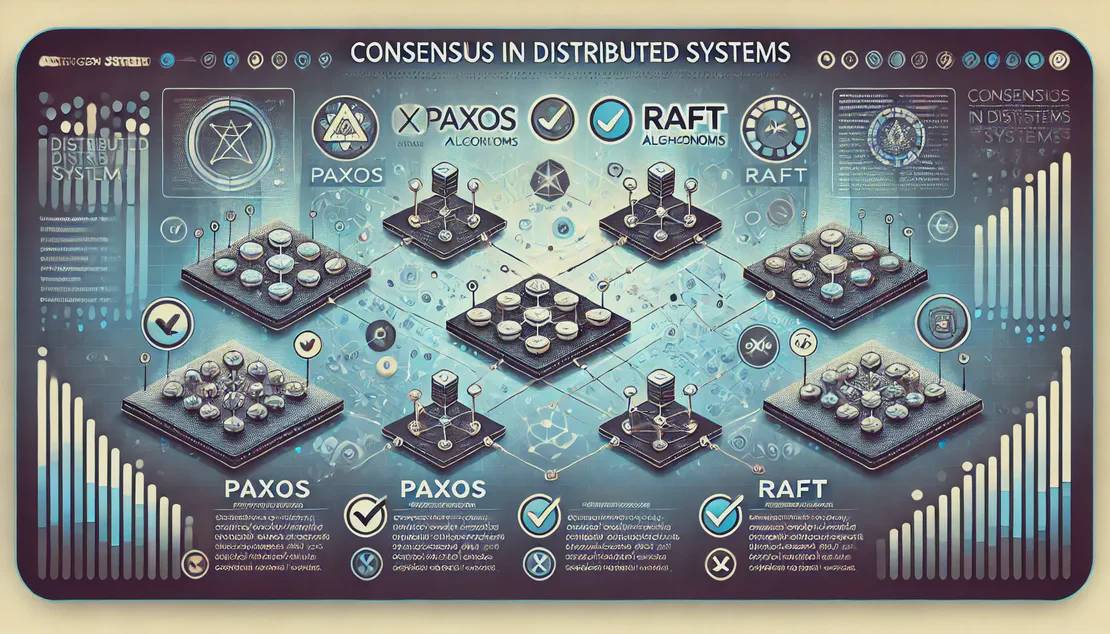
Consensus in Distributed Systems
- Vipul Kumar
- Consensus , Distributed systems , Paxos , Raft
- December 14, 2024
Table of Contents
🔄 Definition — Consensus in distributed systems is the process by which multiple nodes agree on a single data value or course of action, ensuring consistency and reliability despite potential failures.
📜 Importance — It is crucial for maintaining data integrity, fault tolerance, and coordinated actions in decentralized networks, such as blockchain and distributed databases.
⚙️ Algorithms — Key consensus algorithms include Paxos, Raft, and Byzantine Fault Tolerance (BFT), each designed to handle different types of failures and network conditions.
🚧 Challenges — Achieving consensus is difficult due to network partitions, node failures, asynchronous communication, and Byzantine faults, which require robust algorithms to ensure system reliability.
🔗 Applications — Consensus is vital in applications like blockchain, cloud computing, and distributed databases, where agreement on data states or transactions is essential.
Key Algorithms
📘 Paxos — A classic algorithm ensuring agreement on a single value, even with node failures. It involves roles like proposers, acceptors, and learners to achieve consensus.
📗 Raft — Simplifies consensus by electing a leader to manage log replication. It is widely used in systems requiring strong consistency, like key-value stores.
📙 Byzantine Fault Tolerance — Designed to handle arbitrary or malicious node failures, ensuring system correctness even under Byzantine faults.
🔍 Comparison — While Paxos and Raft focus on crash failures, BFT addresses more complex Byzantine failures, making it suitable for high-security applications.
🛠️ Use Cases — These algorithms are used in distributed databases, blockchain, and systems requiring reliable state machine replication.
Challenges in Consensus
🌐 Network Partitions — Communication failures can lead to partitions, requiring algorithms to ensure eventual agreement despite these disruptions.
💥 Node Failures — Nodes may crash or become unreachable, necessitating protocols that maintain system consistency and operation.
⏳ Asynchronous Communication — Delays and message reordering pose challenges, demanding algorithms that can handle such uncertainties.
🛡️ Byzantine Faults — Malicious or arbitrary node behavior requires robust algorithms like BFT to maintain system integrity.
🔄 Scalability — As systems grow, maintaining efficient consensus becomes more complex, requiring scalable solutions.
Applications of Consensus
🔗 Blockchain — Consensus algorithms like Proof of Work and Proof of Stake are fundamental for transaction validation and maintaining a decentralized ledger.
☁️ Cloud Computing — Ensures data consistency and fault tolerance across distributed cloud services.
💾 Distributed Databases — Consensus is crucial for transaction ordering and state replication, ensuring data integrity.
🕹️ Multi-Agent Systems — Used in coordinating actions and decisions among autonomous agents, such as UAVs and smart grids.
📊 Financial Systems — Ensures reliable transaction processing and agreement on financial data states.
Read On LinkedIn | WhatsApp | DEV TO | Medium
Follow me on: LinkedIn | WhatsApp | Medium | Dev.to | Github


